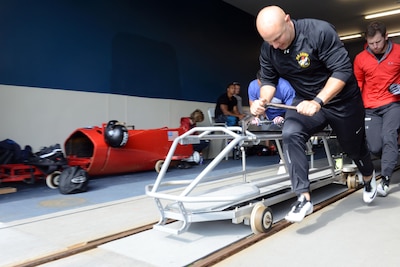By David Vergun Army News Service
LAKE PLACID, N.Y., Aug. 30, 2017 — It's a dog-eat-dog world,
said Army Sgt. Nick Cunningham.
A total of seven bobsled teams are training now at Lake
Placid. But only the top three U.S. bobsled teams in this year's World Cup
standings will get to represent the United States in the XXIII Olympic Winter
Games this February in Pyeongchang, South Korea.
It's a big responsibility to serve as pilot, or driver, on a
bobsled team, Cunningham said.
"I can get someone killed in this sport," he said.
"You're basically going down a twisting mile-long track at 90 mph with no
seatbelt. We go flat out. We don't touch the brakes until we reach the
bottom."
Accidents happen often, he said, though he was quick to
point out that they are not always fatal.
"Everyone crashes and lots of guys have gotten ice
burns," he said.
There's a fine line between going out of control and making
a safe run, Cunningham said.
Explosive Power Training
Cunningham described the training process, which begins
months and even years prior to the Winter Olympics.
During the summer months, there's no ice track to practice
on. Instead, teams use a push track at the Olympic Training Center here. It's
basically a railroad track with a modified bobsled frame on railway wheels.
Because the track is straight, it's not necessary to steer.
Instead, the teams use the push track to practice getting their sled up to
speed. It's all about getting a good start, Cunningham said. Every team member,
including the driver, is involved in helping the sled gain momentum at the
start of the race.
"We need to move that 300-pound sled 50 meters in about
5 seconds," he said.
That push training is accompanied with a lot of
weightlifting in the gym and sprints on a track that is adjacent to the push
track. In other words, a lot of explosive power training is involved.
Besides power training, there's a bit of choreography that
goes with the sport.
"You want to ensure you're running at full speed -- not
chopping your steps -- because all velocity needs to be going forward,"
Cunningham said.
That choreography also involves good teamwork, with everyone
getting in step, he said. It's the driver's job to ensure that the team is
working well together and is "loading" when they're supposed to,
meaning piling on the bobsled after the push phase.
"I need to put a team on the hill that can
compete," he said. "Otherwise, my Olympic shot is over. Less than a
tenth of a second separates the winners from the losers."
Once the pushing phase is done, most of the rest of the work
falls on the shoulders of the driver, he said.
While Cunningham is steering, the job of the others on the
bobsled is to basically stay put and keep in synch with the sled.
"They're trying to be fluid with the sled," he
said, meaning ever so slightly adjusting their posture with the sled as it hits
the curves.
Races Leading Up to Olympics
The Olympic teams won't be named until January. Between now
and then, the bobsledders will participate in eight World Cup races: two in the
U.S., one in Canada, three in Germany, one in Austria and one in Switzerland.
Every track is different, Cunningham said. So before each
race, the athletes study each track and do practice runs. For Cunningham, this
means concentrating on hitting his marks, which are called steering points.
As for the Pyeongchang track, he said, all of the
bobsledders have already visited it and have studied it meticulously.
"I went to South Korea and took notes on the
track," he said. He said he found that the track in South Korea has
difficult, unique curves that require intense situational awareness.
"You have to be perfect all the way down," he
said.
The second curve will be the hardest, he said. "It's
where you can go from first place to last if you miss your mark."
Veteran Olympian
With a lot of newbies practicing to make Team USA,
Cunningham is considered a veteran, since he's already competed in two Winter
Olympics.
Cunningham started bobsledding in 2008 and was immediately
selected as an alternate for the World Cup team. In 2010, he made his first
Olympic team in Vancouver, Canada, as a brakeman for Army Capt. Mike Kohn
before making the transition to a driver.
Today, Kohn, a soldier with the Virginia Army National
Guard, is his coach.
In Vancouver, Cunningham placed 13th in the four-man
bobsledding event and 12th in the two-man.
In 2014, Cunningham, now a driver, placed 12th in the
four-man and 13th in the two-man races.
Along the way to the two Winter Olympics, he picked up a
number of gold, silver and bronze medals in the various World Cups.
Cunningham said he joined the Army after hearing about the
opportunity to participate in the World Class Athlete Program, shortly after
his first Winter Olympics.
As an activated soldier, he said he still has to qualify
with annual weapons and physical fitness training. His military occupation is a
carpentry and masonry specialist.
The Army training, he said, was excellent, and he feels
confident that with the knowledge and experience he acquired, he could build
his own house if he wanted to.
Cunningham lives in Lake Placid, but he said his hometown is
Monterey, California. His girlfriend lives there as well, he said.
"She's been very supportive of me,” Cunningham said.
His parents are also rooting for him, he added.

No comments:
Post a Comment